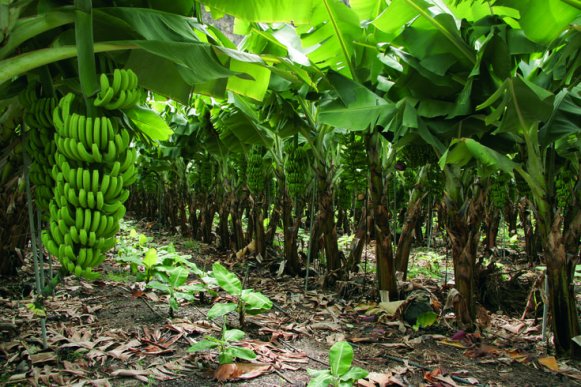
ORIGIN AND HISTORY OF THE PLANTAIN
For the different ways of participating in food: cooked (green or ripe) or as fresh fruits; for its double function: food and medicine; for having mitigated the hunger to the human being during centuries and to have conquered the world, the species of the Banana is considered the king of the vegetables.
Bananas and plantains represent the number one fruit crop in the world, both in terms of production, around 98 million tons, and trade, valued at more than US $ 4,306 million.
It is considered that the banana, as it is known internationally to the banana fruit, was one of the first fruits cultivated by man; the oldest references concerning Banana appear in the Ramayana, an epic poem written in Sanskrit centuries ago.
The magnificent Borobudur Buddhist temple, built in Central Java, Indonesia, around 850 BC, shows stone carvings of bananas offered to the god Buddha.
The victorious armies of Alexander the Great describe their cultivation in the lower part of the Hindus valley in India, in the year 327 BC, where there were already written references between the years 600-500.
The south of China is another area where the cultivation of Banana and Banana goes back to ancient times, the writings of the ruling period of the Han dynasty (206-220), mention that the cultivation of Banana and Banana was practiced for more than 2000 years Due to the antiquity, to its long history of domestication in India and China, and to the great diversity of dessert and cooking cultivars found in these countries, some writers believed that bananas and plantains had their origin there.
However, the results of the banana and banana exploration missions in Asia, in the middle of the last century, and the subsequent revelation of the great wealth of the Musa germplasm resources that were collected, showed that the most probable thing is that the bananas and the bananas really originated in Southeast Asia, in the so-called Malay Archipelago or Indo Malaya region in South Asia, and in a wide region that stretched from northeastern India to northern Australia. From Indonesia they spread south and west, reaching Hawaii and Polynesia by stages.
European merchants brought news of the tree or plant to Europe around the 3rd century BC. C., It is known in the Mediterranean since 650, the species reached the Canary Islands in the fifteenth century, but did not introduce it until the twentieth century in Europe. From the plantations of West Africa and the Canaries, the Portuguese and Spanish colonizers would take it to South America in the sixteenth century. Commercial cultivation began in the Canaries at the end of the 19th century and the beginning of the 20th century. In the twentieth century this crop becomes one of the most cultivated in Central and South America, being one of the main lines of export in tropical countries and becoming the fourth crop worldwide, both for its consumption, export and high labor that requires for its production, in the last hundred years has undergone great technical transformations its cultivation and its commercialization.
The theory on the arrival of the banana to Colombia has two lines: the first says that the plant was taken by the Arabs to Spain and, from there directly to America, or via the Canaries, with the Spanish colonizers; it enters through the Darién area and spreads throughout the Pacific coast. Others say that the Dominican Fathers brought it by the Orinoco, entered the Eastern Plains and was first planted in the municipality of San Martín, in the current department of Meta.
It is fully established that the Musaceae originated in Southeast Asia; however, its worldwide distribution only occurred about 2000 years ago, at present the Banana is planted mainly in Africa, where it was initially taken to the eastern region by Indonesian immigrants via Madagascar, and later transferred to the west coast by the Portuguese, where it was very popular in countries that had ecological conditions in the humid tropics, such as Uganda and Rwanda, which produce a high percentage of the world harvest.
The continuous regrowth of the Banana symbolizes, in Indian culture, fertility and prosperity; Both the fruit and the leaves are gifts and usual ornaments during the marriage ceremonies. In the rice fields, a Banana or Banana plant is sometimes planted in a corner to attract good luck. In Malaysia the leaves are used ritually in ablutions performed by women for two weeks after childbirth.
Nowadays commercial varieties of Banana are grown in all the tropical regions of the world. It is, together with Banana, the most cultivated of tropical fruits and one of the four most important in global terms, only behind the grape (Vitis vinifera), citrus (orange) and apple.
The great Pliny speaks of the banana or shovel in his book XII: "that the muse that walks in Paradise, is behind the tree that the wise eat", hence the scientific name of Musa paradisiaca, which is equivalent to saying: Musa sapientum, food of wisdom.
It seems likely that man has used Banana throughout its history in Southeast Asia. This use was based on very old bananas, edible diploids of the Musa acuminata. The first and decisive step in the evolution of the edible banana was the origin of the parthenocarpy and disappearance of the seed of the Musa acuminata. Subsequent changes were based on the hybridization of M. acuminata with M. balbisiana and the appearance of triploid and tetraploid characters between the products.
The oldest references to the cultivation of Banana come from India, where citations appear in the epic poetry of primitive Buddhism from 500-600 a.C. Another reference found in the writings of Jataka Buddhism, around 350 a.C suggests the existence, 2000 years ago, of a mutant clone very similar to Curraré, because there is talk of a fruit as big as "tusk of elephant". In the Mediterranean of classical times, Banana was known only by hearsay; It was described by Megasthenes, Theophrastus and Pliny. All the authors seem to agree that the plant arrived in the Mediterranean after the conquest of the Arabs in 650 AD. In Africa it was taken from India, through Arabia, and then south, crossing Ethiopia to the north of Uganda approximately in the year 1,300 AD, although this opinion is not entirely satisfactory, therefore, there is evidence that there was a fairly long contact with the original source of the clones, so its presence is older on the African continent.
Hence, it is said that plantain cultivation was started in Africa routinely by the primitive population, within which consumption was important. European colonization technified it to become a source of generalized and economic food. The French colonization made in this sense the greatest efforts, by means of competent professionals who made long and patient works directed to this technification. This works and investigations were extended to their territorial possessions in the Antilles. At the end of the 19th century, the Banana was an unknown plant in Europe, where very few specimens had arrived, brought from the tropical regions by traveling naturalists, which were preserved as Precious rarities in the warm greenhouses of some museums in the European capitals. The banana was considered as an exotic fruit that occasionally arrived at the ports of the temperate zone, due to the anticipation of the crew, who, to improve their diet during the voyages, embarked some bunches on their stopovers in the Mares del South.
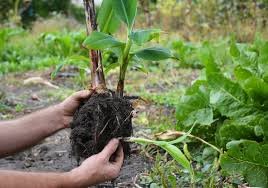
MORPHOLOGY
Root.
The radicular system is superficial of the fasciculate type, characteristic of the monocotyledonous plants, formed by secondary roots in the form of hair that serve as support and anchor to support the aerial part of the plant. The perennial element is the rhizome, superficial or underground, which has meristems from which fibrous roots are born, which can reach a depth of 1.5 m and cover 5 m of surface. Stems or "suckers" sprout from the rhizome, replacing the main stem after flowering and dying. In the cultivated specimens only one is normally left to avoid weakening the plant, but in the wild they appear in great quantity; they are the main form of diffusion in the sterile varieties, which are the majority.
The roots of the Banana are very superficial and 90% of them are in the first 30 cm of the soil; Root development is also seriously affected by the texture of the soil and is a factor to be taken into account when applying irrigation: in sandy loam soils the root development is much higher and what is more important; It explores greater depths than when the crop is located in a loamy loamy soil, which is why the crop located in the first soils better withstands less rainy seasons than in clay soils.
The roots of the species of the genus Musa originate in the cambium of the corm, forming groups of 3 or 4, they grow horizontally and very close to the surface of the soil. Studies on the roots of the musáceas carried out by Swennen, (1986), found that there is great difference between the roots of the Banana and those of the Banana; in Banana, 0.32% are primary roots, 22.40% are secondary and 77.28% are tertiary; On the other hand, in the Banana, 0.68% are primary roots, 53.44% are secondary and 45.88% are tertiary. Likewise, in the Banana, 97.7% of the secondary roots are covered by tertiary roots, while in the Banana only 66.1% are.
For the above reasons, Banana is more resistant than Banana to adverse conditions such as drought and possibly one of the reasons why there are no significant differences in the weight of the clusters of the continuous production cycles. In the same way, the small length of the roots and especially the low proportion of tertiary roots in the banana, is what makes the banana have higher productivity than the banana, according to research.
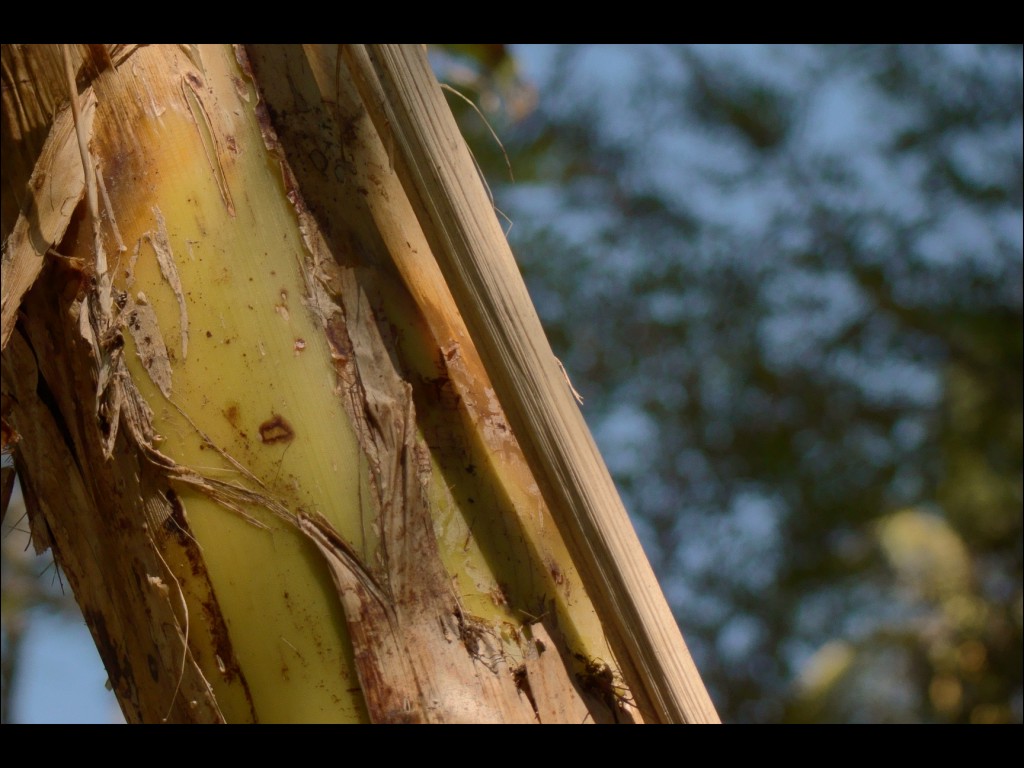
Stem.
The true stem is a large, starchy rhizome, underground, which is crowned with buds; which develop when the plant has flowered and fructified, gives rise to roots and petioles, whose pods or socks that will form the pseudostem or false stem. As each sucker of the rhizome reaches its maturity, its terminal bud becomes an inflorescence (bacota), which is pushed up from the inside of the soil by the lengthening of the true stem through the apparent or false stem, until it emerges above the pseudostem, which can reach heights up to 4 meters.
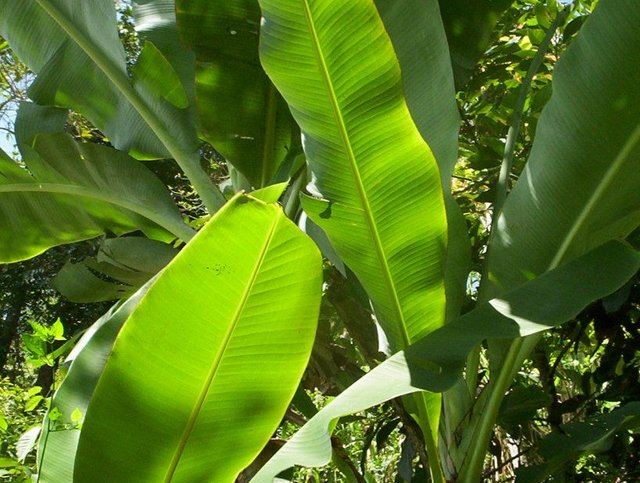
Leaves.
Banana leaves are included among the largest in the plant kingdom; son of green or light greenish yellow color, with smooth margins and pinnate veins. The leaves tend to break spontaneously along the ribs, giving them a disheveled appearance. Each plant normally has between 5 and 15 functional leaves (it can reach 34 to 36 in the whole cycle, when the crop is sown), 10 being the minimum to have it mature; the leaves do not live more than the months, and the tropics are renewed for a reason of one per week in the growing season. They are smooth, tender, oblong, with the apex truncated and the base round or slightly cordiform, green on the upper surface and lighter and normally glaucous on the underside, with yellowish or greenish veins.
Arranged in spiral, they unfold until reaching 3 m in length and 60 cm in width; the petiole is up to 60 or 100 cm. The petiole, which joins the sheath and the limbus, is elongated elliptical, slightly decurrent towards the petiole; in varieties with a greater genetic component of M. balbisiana, this is concave on the upper part, with the ends almost touching above the axial channel. Genetics also depends on whether it is glabrous or pubescent. The old leaves are easily opened transverse by wind.
APPLICATIONS
Due to the great variety of hybrids, varieties and clones that the plantain plants present, there are different sizes, shapes, flavors and consistency of the fruits, making bananas and, from their relative, bananas, an extremely versatile food, in addition to medicinal uses, its vegetable part (leaves and stems) has important applications in industry and crafts. Nutritional value. It is important to note its nutritional value high in vitamins A and C, phosphorus and potassium, although it contains other minerals and vitamins in small quantities, its caloric valu
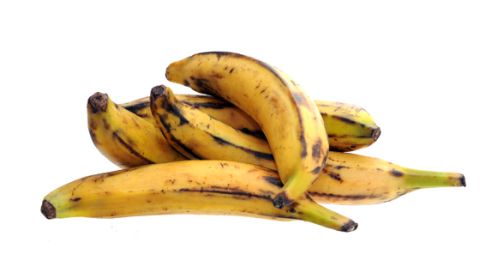
NUTRITIONAL CONTENTS
According to Simmonds (1973), the banana pulp contains B-carotene (vitamin A) 2.4 ppm and pyridoxine (vitamin B6) 3.2 ppm. Velásquez (2003) reports that the pulp contains B-carotene (vitamin A) 1.75 ppm and ascorbic acid vitamin C 200 ppm; in addition, it is reported that, for every 100 grams of edible portion, Magnesium content 36.4 mg; Potassium 350 mg; Provitamin A 18 mcg; Vitamin C 11.5 mg; Folic acid 20 mcg.
The banana not only uses its fruits, but also the plant as such, the phytopharmaceuticals derived from it have therapeutic properties due to the active ingredients they contain, among them: phenols, tannin, amines, nucleosides and organic acids. The pulp of the fruit contains serotonin and dopamine, as well as norepinephrine.
After the fruit is harvested, stems, leaves, flowers and roots can be used to make flour, vinegar, paper, cakes (pastry), processed wood, animal feed, dyes and others; hence its importance as a crop in tropical countries, because it can be a cheap food and its by-products are used to the maximum.
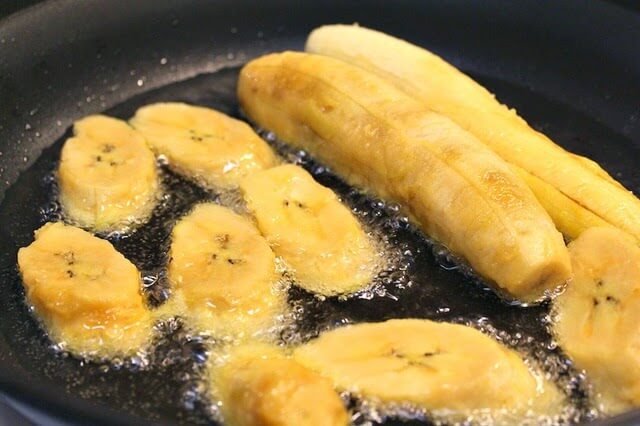
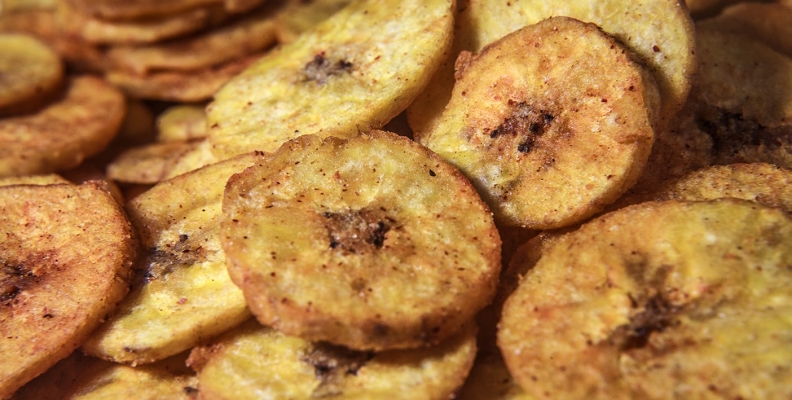

GASTRONOMY
In the West, the most frequent and simplest form of Banana consumption is as a dessert fruit, served whole and using the peel to hold it without the hands coming into direct contact with the pulp. This variety of musaceas can be transformed into ice cream, sweets, cakes and other presentations. On the other hand the banana is oxidized (it takes dark coloration) in contact with the air, so it is preferable to peel it at the last moment, when this is not possible, it must be wetted with lemon, lime or orange juice.
preparation:
Bananas are consumed invariably cooked, in Central America the ripe bananas are fried in butter or oil; the preparation, to which milk is sometimes added, is called mangú, and is the usual garnish for daily food. This name also applies to the boiled green banana puree, which is accompanied by eggs, salami, onion pickle or avocado. The tostones (sliced plantain and fried fries) are served to accompany meats. The leaf cake is made with a mass of ripe banana and other foods, which is cooked wrapped in the banana leaf (it is visually similar to the Mexican tamale). Stepped on and mixed with flour, milk, butter and egg, they are used to prepare a dough that is mixed with meat and cheese and baked; they are also used green, boiled and served with honey, cooked in syrup, or cut into slices (slices) that are fried until crispy, to accompany meats and other dishes. In Puerto Rico the mofongo is popular, a puree of green plantain, garlic and other garnishes. The fried or green plantain slices are prepared and packaged industrially.
In Colombia, plantain is essential in the family basket, whether cooked to accompany various dishes, such as beans, stew or soups, fried consumption is common; either green or ripe in slices, patacones or pieces of green or ripe plantains, which are fried, then steeped and fried again (patacón pisao), the "bun" or ripe banana with other seasonings that are cooked wrapped in the leaves , it serves as an accompaniment to meats and other foods, besides, it is raw material for the confectionery in the preparation of cakes, sweets, open cut bananas, mazamorra, imprisoned, purée, compotes, coladas, flours, starches, fermented, roasted, also consumed raw, sometimes, if they are well ripe they are eaten fresh like bananas.
The cooked bananas are sold packed in slices of crispy consistency, green or ripe (ripe), bananas and banana raisins; In the Urabá area, all these agroindustrial transformations are being elaborated with the banana to add value to the product, so that the export is not only of fresh green fruit, in addition to the preparations in desserts packed in vacuum, for internal consumption and international, in general, can be used as fruit and as a vegetable.
Other more rare products, but that enjoy some use; In Africa, for example, alcoholic beverages are prepared by the controlled fermentation of ripe fruits, and vinegar has been made from them. Tender shoots are consumed boiled as a vegetable in India and Africa, where they constitute an important food in case of famine. They are prepared in curries with other vegetables, or they are roasted until the carbonization for its use as a dressing for other vegetable products. The terminal bud of the inflorescence, which contains male flowers, is cooked and consumed as a vegetable after macerating it in brine to eliminate the tannins; in the varieties that do not lose the masculine flowers, these are plucked at times to use in this way.
Banana in the Urabá area is fundamental within the daily diet, however, due to the decrease in international consumption, since it is exported as fresh fruit, the revaluation of the peso and therefore the fall in the price of the dollar, the inputs have become more expensive, and the producers increased the prices to the intermediary and the final consumer, so the family diet is suffering the consequences, also, some years ago, the farms gave away what is called the reject banana or banana that is soon to mature, nowadays everything is sold for the interior of the country and prices in the area have increased rapidly. It is also used as a supplement in livestock feed, poultry and pigs
COMMON NAMES
There are three different Banana or Banana species: the sweet variety or the fruit that in Central and South America we call the banana (musa sapienta or sapientum and musa nana), the Banana (paradisiacal musa), also known as varieties for stewing, and the inedible and ornamental varieties (musa textilis and musa ensete). Most varieties of banana have yellow skin, but there are also pink, red or purple skin. The flavor and texture vary equally and some may be more mealy or sweeter than others.
The name plantain, banana tree, banana, banana tree, cambur, topocho or guineo groups a large number of herbaceous plants of the genus Musa, both hybrids obtained horticulturally from the wild species of the genus Musa acuminata and Musa balbisiana as genetically pure cultivars of these species. Originally classified by Carl von Linnaeus as Musa paradisiaca in 1753, the type species of the genus Musa, subsequent studies have led to the conclusion that the complex taxonomy of the genus includes numerous hybrids of varying genetic composition, and a strictly sui system has been developed. generis classification to account for this variation. However, according to the rules of the International Code of Botanical Nomenclature, the Linnaean name has priority, and is still used, both in its original form and in the modified Musa × paradisiaca, which indicates that it is a hybrid, for designate these varieties generically.
In the traditional nomenclature sometimes a difference is drawn between bananas, consumed raw as a dessert fruit, and bananas, which due to their higher starch content must be roasted or fried before their intake. The difference does not correspond exactly with any genetic criteria; Although the varieties with greater genetic presence of M. balbisiana are usually included in this second group, it can not be determined if a plant will produce bananas or bananas simply because of its genetic constitution. The confusion is increased by the fact that in other regions the terms are considered perfectly synonymous.
In any case, this group of vegetables make up the most consumed intertropical fruit in the world. It is a false berry, falcate or elongated, that grows in clusters of up to one hundred units and 50 kg of weight; Yellow when ripe, it is sweet and fleshy, rich in carbohydrates, potassium, vitamin A and vitamin C. It is much richer in calories than most fruits because of its high starch content; of the 125 g that weighs on average, 25% is dry matter, which contributes about 120 calories. They are grown in more than 130 countries, from Southeast Asia where they are native, to Oceania and South America.
¡thank you friends for taking a little time and look at my publication! is very important to have a knowledge of where the things we like so we can give more value to them and this rich fruit plays an important part for us in our daily nutrition Personally I would never tire of cooking it no matter where in the world I am, greetings and have a nice afternoon.